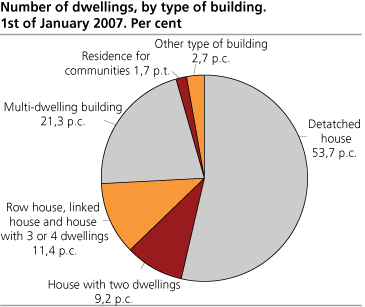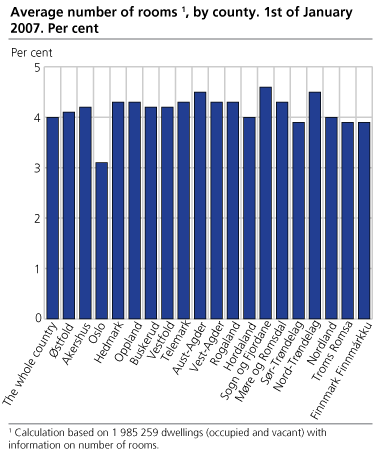Content
Published:
This is an archived release.
478 000 flats in multi-dwelling buildings
At the first of January this year almost 2 243 000 dwellings were registered in Norway. During the last years, the building of flats in multi-dwelling buildings has become most common. A total of 478 000 dwellings are registered in multi-dwelling buildings.
Detached houses are, however, the most common type of dwelling, with 1.2 million. In addition, a total of 255 000 dwellings are registered in row houses, linked houses and houses with three or four dwellings, 205 000 dwellings in houses with two dwellings and 39 000 dwellings in residence for communities. More than 60 000 dwellings are registered in buildings where the main part of the floor space is used for other purposes than dwellings, mainly industrial buildings.
Increase in the number of flats
Since 1st of January 2006 the number of flats in multi-dwelling buildings has increased with 15 121. In comparison, there has been an increase of 4 480 dwellings in row houses, linked houses and houses with three or four dwellings, 4 305 more detached houses and 2 663 more dwellings in houses with two dwellings. The total number of dwellings has increased by 1.3 per cent during last year.
Both apartments and bed-sits are counted as dwellings. For the time being, the statistics does not distinguish between occupied and vacant dwellings, and therefore include all dwellings registered as active in the Ground Parcel, Address and Building Register (GAB).
Smallest dwellings in Oslo
Oslo has, with its many flats, a high share of small dwellings. As much as 20.7 per cent of the dwellings in Oslo have less than 50 square metres of utility floor space. In the country as a whole, only 8.5 per cent of the dwellings are classified in this size group. At the same time, only 9.0 per cent of the dwellings in Oslo have more than 160 square metres of utility floor space. In Rogaland, we find the largest dwellings, with 31.6 per cent of the dwellings with more than 160 square metres of utility floor space. For the country as a whole, the share of dwellings larger than 160 square metres is 22.8 per cent. Statistics Norway is, however, missing information about size for 7.7 per cent of the dwelling stock, which makes the comparison difficult.
The number of rooms is four
The average number of rooms in Norwegian dwellings is four rooms. Oslo is, with an average of 3.1 rooms, the county with the lowest average number of rooms. Sogn og Fjordane has, on the other hand, an average of 4.6 rooms per dwelling. The average number of rooms is based on the 1.98 million dwellings with information about number of rooms. Dwellings with four rooms are most common, followed by dwellings with three rooms. 21.6 per cent of the dwellings have four rooms, while 18.3 per cent of the dwelling stock has three rooms.
Comparability with the Housing Census in 2001The register based dwelling statistics can not be compared directly with the Housing Census in 2001 . The Housing Census covered 1.96 million occupied dwellings, while the statistics on the dwelling stock include all dwellings, both occupied and vacant. Improvement of the GAB-registerThe municipalities are cleaning up their registers to improve the quality. This is being done continually and also especially in connection with the transition to the new official building register, “Matrikkelen”. Dwellings that were incorrectly classified the previous year may have been assigned the correct information the following year. The number of registered dwellings in the municipalities may also change from year to year because of the clean up. As a result, the number of dwellings in some of the municipalities may not be compared directly with the previous year. Extension of the statisticsDuring the first half of 2008, we will publish figures of the dwelling stock at the 1st of January 2008. The plan is then to extend the statistics with more information about the dwellings. It will then be possible to distinguish between occupied and vacant dwellings. More about comparability, quality and other information can be found in “About the statistics” . |
Tables:
- Table 1 Number of dwellings, by type of building and county. 1 January 2007
- Table 2 Number of dwellings, by type of building, county and municipality. 1 January 2007
- Table 3 Number of dwellings, by type of building and year of construction. 1 January 2007
- Table 4 Number of dwellings, by year of construction and county. 1 January 2007
- Table 5 Number of dwellings, by type of building and utility floor space. 1 January 2007
- Table 6 Number of dwellings, by utility floor space and county. 1 January 2007
- Table 7 Number of dwellings, by year of construction and utility floorspace. 1 January 2007
- Table 8 Number of dwellings, by type of building and number of rooms. 1 January 2007
- Table 9 Average number of rooms , by type of building and county. 1 January 2007
- Table 10 Number of dwellings, by type of building and number of bathrooms and toilets. 1 January 2007
Contact
-
Jens Mathiesen
E-mail: jens.mathiesen@ssb.no
tel.: (+47) 40 81 13 98
-
Mona Takle
E-mail: mona.takle@ssb.no
tel.: (+47) 40 81 14 12


